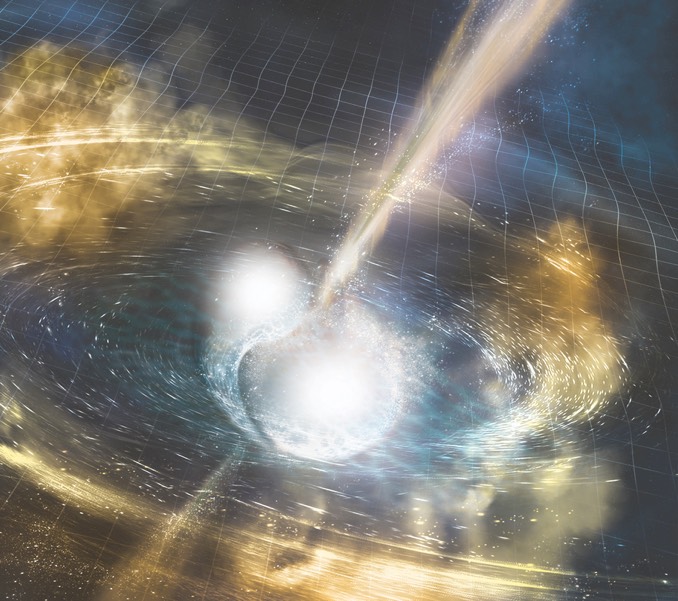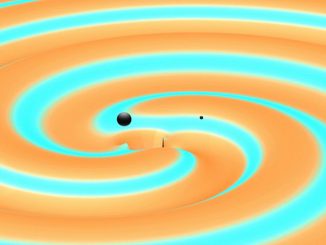
After major upgrades, the LIGO and Virgo gravitational wave detectors have five possible events in just one month of observation: three black hole mergers, one smashup between two compact neutron stars and, on 26 April, a possible collision between a neutron star and a black hole. If confirmed, the observation would mark another first in the emerging field of gravitational wave astronomy.
“The universe is keeping us on our toes,” Patrick Brady, chief spokesperson for the LIGO Scientific Collaboration, said in a statement. “We’re especially curious about the April 26 candidate. Unfortunately, the signal is rather weak. It’s like listening to somebody whisper a word in a busy café, it can be difficult to make out the word or even to be sure that the person whispered at all. It will take some time to reach a conclusion about this candidate.”
The Laser Interferometer Gravitational-wave Observatory, or LIGO, is operated by Caltech and MIT. It consists of two observing stations, one in the state of Washington and the other in Louisiana, both featuring a pair of 4-kilometre (2.5-mile-long) vacuum tubes joined in an L shape. The Virgo detector at the European Gravitational Observatory near Pisa, Italy, features slightly shorter arms.
Laser beams fired down each arm bounce back and forth between mirrors, then are recombined and analysed. The system is set up so that the crests of light beams from one vacuum tube exactly match up with the troughs of the other, creating destructive interference. In the absence of gravitational waves or any other outside influence that could affect the distance the photons travel, light in each vacuum tube covers exactly the same distance before it is recombined. In that case, the detectors do not “see” anything.
But according to Einstein’s general theory of relativity, a gravitational wave passing through Earth would stretch space in one direction and compress it in a perpendicular direction, effectively stretching the space between the mirrors in one vacuum tube and slightly shrinking it in the other.
Because the laser beams travel slightly different distances during the passage of a wave, the crests and troughs no longer match up when the beams are recombined. The resulting interference pattern can be analysed to determine exactly how much stretching and shrinking went on.
That, in turn, allows scientists to reverse engineer the sort of event needed to generate such distortions and even determine their general direction. Other observatories can then search for electromagnetic radiation from such events to gain additional insights and to pinpoint their locations.

The recent upgrades to LIGO and Virgo have enhanced their sensitivity, allowing astronomers to detect more gravity wave events and raising hopes that much more mundane phenomena than black hole mergers will soon be within reach.
“This run opens a new era in gravitational wave astronomy, one in which detection candidates are being publicly released as quickly as possible after we take the data,” Brady told reporters during a 2 May teleconference to announce the new results.
“In just one month of observing, we’ve identified five gravitational wave detection candidates … made possible by substantial improvements in the LIGO and Virgo detectors over the past 18 months. Three of the detection candidates so far are consistent with binary black hole mergers similar to the first event we discovered back in 2015. The fourth candidate, discovered on the 25th of April, is likely to be from the merger of two neutron stars.”
The LIGO and Virgo detectors have now collected evidence for 13 black hole mergers in total, two neutron star collisions and one possible neutron star-black hole merger.
“The great thing about where we are right now is we’re just beginning to see the field of gravitational wave astronomy open,” Brady said. “As the detectors go through a sequence of improvements over the next decade, we’re going to have the capability of seeing things throughout the universe, the possibility to perhaps measure gravitational waves from spinning neutron stars and even things we haven’t yet thought of as serious sources.
“And that’s a big thing for us. Opening up a new window on the universe like this will hopefully bring us a whole new perspective on what’s out there. … As we get to see more of these (events), we’ll be able to understand essentially how stars die and how neutron stars and black holes form as the end products of stellar evolution. There’s just a huge range of new and exciting things that we hope to get a handle on using gravitational waves.”



